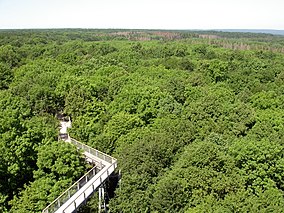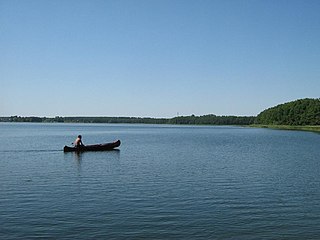
The Müritz National Park is a national park situated roughly in the middle between Berlin and Rostock, in the south of the German state of Mecklenburg-Vorpommern. It extends over large portions of the Müritz lakeland in the district of Mecklenburgische Seenplatte. Müritz National Park was founded in 1990. The total area is 318 km2. Near the city of Waren visitors can get information on the national park at the Müritzeum. The beech forests within the national park were inscribed on the UNESCO World Heritage List in 2011 as an extension of the Primeval Beech Forests of Europe site because of their unspoilt nature and testimony to the ecological history of Europe since the Last Glacial Period.

The Jasmund National Park is a nature reserve on the Jasmund peninsula, in the northeast of Rügen island in Mecklenburg-Vorpommern, Germany. It is famous for containing the largest chalk cliffs in Germany, the highest of which is Königsstuhl, rising to 118 m (387 ft) above the Baltic Sea. The highest point in the park as a whole is Pieckberg, at 161 m (528 ft) above sea level. The beech forests behind the cliffs are also part of the national park.
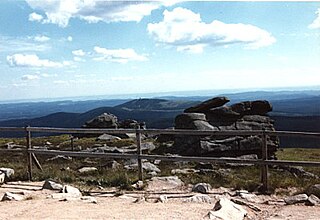
Harz National Park is a nature reserve in the German federal states of Lower Saxony and Saxony-Anhalt. It comprises portions of the western Harz mountain range, extending from Herzberg and Bad Lauterberg at the southern edge to Bad Harzburg and Ilsenburg on the northern slopes. 95% of the area is covered with forests, mainly with spruce and beech woods, including several bogs, granite rocks and creeks. The park is part of the Natura 2000 network of the European Union.
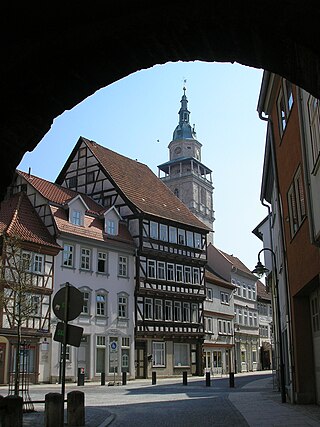
Bad Langensalza is a spa town of 17,500 inhabitants in the Unstrut-Hainich district, Thuringia, central Germany.
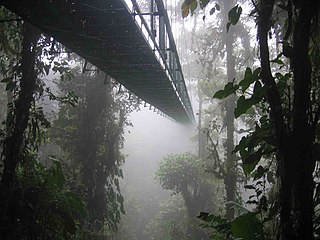
Canopy walkways – also called canopy walks, treetop walks or treetop walkways – provide pedestrian access to a forest canopy. Early walkways consisted of bridges between trees in the canopy of a forest; mostly linked up with platforms inside or around the trees. They were originally intended as access to the upper regions of ancient forests for scientists conducting canopy research. Eventually, because they provided only limited, one-dimensional access to the trees, they were abandoned for canopy cranes. Today they serve as ecotourism attractions in places such as Dhlinza Forest, KwaZulu-Natal, South Africa, Taman Negara National Park, Malaysia, Sedim River, Kulim, Nyungwe National Park, Rwanda and Kakum National Park, Ghana.

Bieszczady National Park is the third-largest national park in Poland, located in Subcarpathian Voivodeship in the extreme southeast corner of the country. In 2021, the national park became a UNESCO World Heritage Site.

Tyresta National Park is a national park with a surrounding nature reserve in Sweden, located in Haninge and Tyresö municipalities in Stockholm County.

Poloniny National Park is a national park in northeastern Slovakia at the Polish and Ukrainian borders, in the Bukovské vrchy mountain range, which belongs to the Eastern Carpathians. It was created on 1 October 1997 with a protected area of 298.05 km2 (115.08 sq mi) and a buffer zone of 109.73 km2 (42.37 sq mi). Selected areas of the park are included into Primeval Beech Forests of the Carpathians UNESCO World Heritage Site.

The Parco Nazionale delle Foreste Casentinesi, Monte Falterona, Campigna is a national park in Italy. Created in 1993, it covers an area of about 368 square kilometres (142 sq mi), on the two sides of the Apennine watershed between Romagna and Tuscany, and is divided between the provinces of Forlì Cesena, Arezzo and Florence.

Hainich is a forested hill chain in the state of Thuringia in Germany, between the towns of Eisenach, Mühlhausen and Bad Langensalza. Hainich covers an area of around 160 km², of which, since 31 December 1997, half has been designated as Hainich National Park. The highest point in Hainich is Alte Berg at 1621 ft. The Mühlhäuser Stadtwald in the northern part of Hainich is the largest municipal forest in Thuringia. The landmark of Hainich is Betteleiche, a 600-year-old common oak at Ihlefeld.

Ancient and Primeval Beech Forests of the Carpathians and Other Regions of Europe is a transnational serial nature UNESCO World Heritage Site, encompassing 94 component parts in 18 European countries. Together, the sites protect the largest and least disturbed forests dominated by the beech tree. In many of these stands, these forests here were allowed to proceed without interruption or interference since the last ice age. These sites document the undisturbed postglacial repopulation of the species.

Shebenik National Park is a national park in eastern Albania adjacent to the border with North Macedonia. It encompasses 34,507.9 hectares (345.079 km2) and is specifically marked by a mountainous landscape supplied with glacial lakes, valleys, dense coniferous and deciduous forests and alpine meadows and pastures. Elevations in the park vary from 300 metres to over 2,200 metres above the Adriatic at the peak of Shebenik and Jabllanica, hence the name. It dwells a number of endangered species that are fast becoming rare in Southern Europe, including the brown bear, gray wolf and balkan lynx. The abundance in wildlife can in part be explained by the variety of vegetation types and remote location.
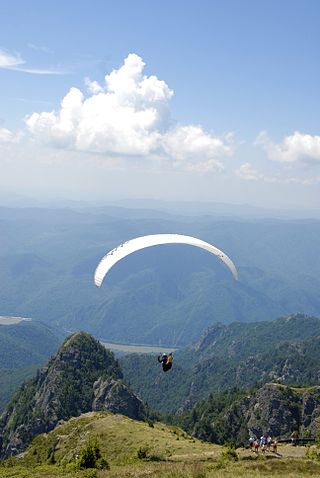
The Cozia National Park is situated in Romania, in the northeast part of Vâlcea County, in administrative territory of localities Brezoi, Călimănești, Racoviţa, Perișani, Sălătrucel and Berislăvești.
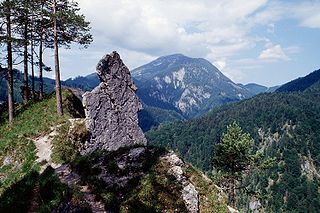
Kalkalpen National Park is a national park within the Northern Limestone Alps mountain range, located in the state of Upper Austria, Austria. The park was established in 1997. The ancient beech forests within the national park were added to the UNESCO World Heritage Site known as Ancient and Primeval Beech Forests of the Carpathians and Other Regions of Europe, because of their undisturbed nature and testimony to the ecological history of Europe since the Last Glacial Period.

Natural beech wood is a beech wood, that is able to replenish and sustain itself on its own.

The wildlife of Ukraine consists of its diverse fauna, flora and funga. The reported fauna consists of 45,000 species when including the areas of the Black Sea and the Sea of Azov. Ukraine's protected environments consist of 33 Ramsar sites covering an area of 7,446.51 square kilometres (2,875.11 sq mi). Biosphere nature reserves and three national parks are all part of the GEF projects portfolio of conservation of biodiversity in the Danube Delta. Their vegetation pattern is mixed forest area, forest-steppe area, steppe area, Ukrainian Carpathian Mountains and Crimean Mountains. Some of the protected areas that were reserves or parks are subsumed under the biosphere reserves.

The Kellerwald-Edersee National Park, CDDA-No. 318077) in the North Hessian county of Waldeck-Frankenberg is a national park, 57.38 km² in area, that lies south of the Edersee lake in the northern part of the low mountain range of the Kellerwald in the German state of Hesse. Since 25 June 2011 the beech forested area of the national park has been part of the UNESCO World Heritage Site known as Ancient and Primeval Beech Forests of the Carpathians and Other Regions of Europe, because of its testimony to the ecological history of the beech family and the forest dynamics of Europe since the Last Glacial Period.

Uzhanskyi National Nature Park is a protected area in Ukraine. It is located in Uzhhorod Raion of Zakarpattia Oblast, at the border with Poland and Slovakia. The park was created on 5 August 1999 and has the area of 39,159.3 hectares (151.195 sq mi). Since 2007, it is part of the World Heritage site Primeval Beech Forests of the Carpathians and Other Regions of Europe. It is also part of the East Carpathian Biosphere Reserve. The park was created to protect pristine beech forest of the Carpathians.

The protected forest area, Uholka-Shyrokyi Luh, is located in the Trancarpathian region of Ukraine and belongs to the Carpathian Biosphere Reserve. It is the largest primeval beech forest worldwide with an area of 8800 ha. Since 1920, some parts of this forest have been protected. In 1992, Uholka-Shyrokyi Luh primeval beech forest was designated as UNESCO World Heritage Site. Later, several other primeval and old-growth beech forests in Europe were included in the UNESCO World Heritage Site Ancient and Primeval Beech Forests of the Carpathians and Other Regions of Europe as well.
As a primeval beech forest, Uholka-Shyrokyi Luh is an important research hotspot. In 2001, a 10 ha research sample plot was installed in Mala Uholka as part of a Swiss-Ukrainian research project, and in 2010 a full statistical inventory of the primeval forest was carried out. The next inventory is planned in 2019 to detect any changes.

The Central European mixed forests ecoregion is a temperate hardwood forest covering much of northeastern Europe, from Germany to Russia. The area is only about one-third forested, with pressure from human agriculture leaving the rest in a patchwork of traditional pasture, meadows, wetlands. The ecoregion is in the temperate broadleaf and mixed forest biome, and the Palearctic realm, with a Humid Continental climate. It covers 731,154 km2 (282,300 sq mi).
